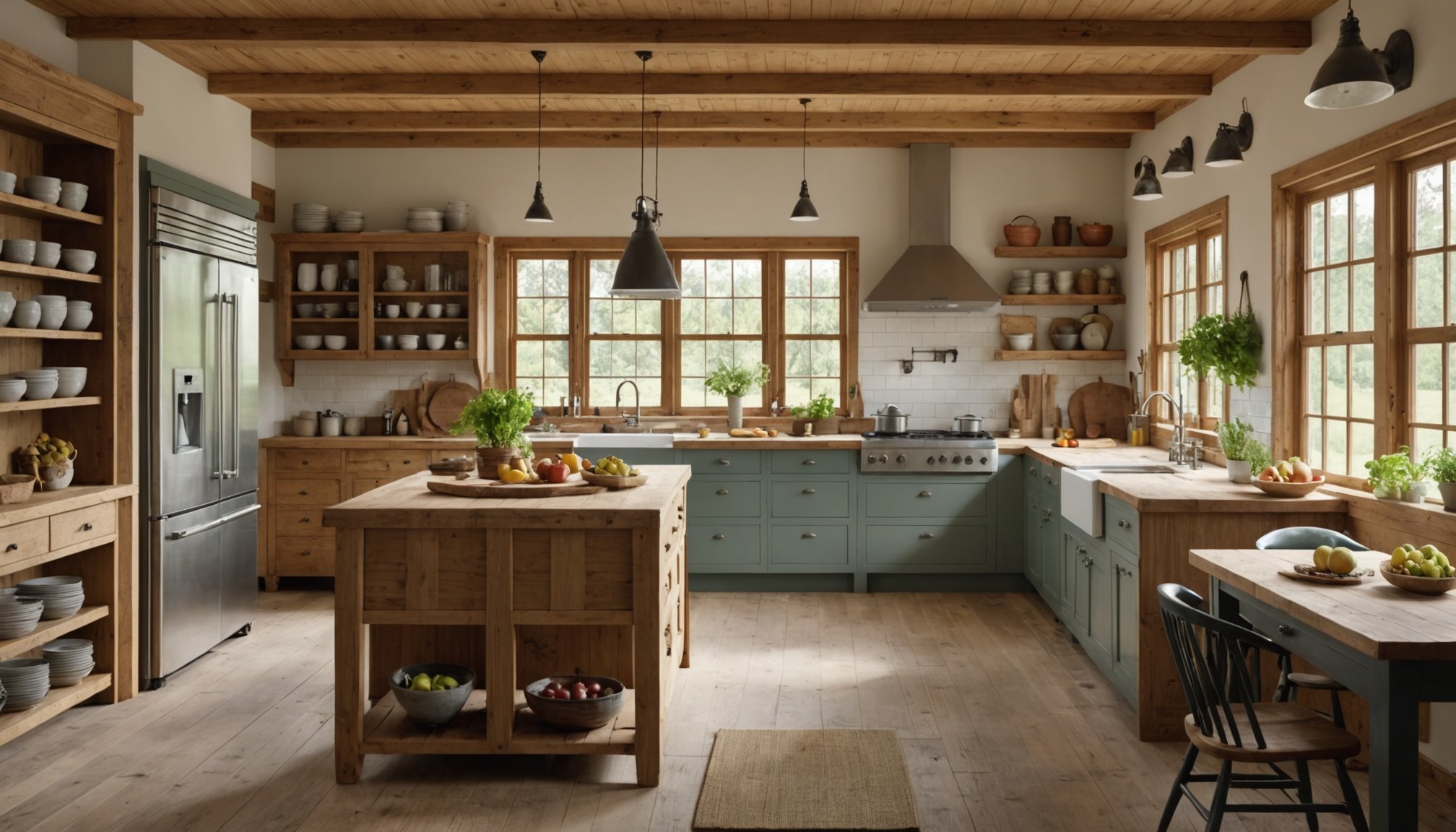Inspirational Farm-to-Table Kitchen Designs
In the pursuit of a farm-to-table kitchen, key design elements focus on promoting sustainability. A crucial aspect involves the use of sustainable design that incorporates eco-friendly aesthetics. Natural lighting and indoor gardening can significantly enhance the space, bringing a taste of nature into the home. Large windows not only provide ample daylight but also help save energy, a simple yet effective sustainable practice.
Kitchen layouts play an essential role in enhancing both functionality and accessibility. Consider an open-plan design, which allows for fluid movement and easy access to frequently used areas. Additionally, incorporating materials like reclaimed wood or recycled stone can elevate the space while staying eco-friendly.
Also read : Seamless spaces: essential tips for a cohesive kitchen and living area design
Creating a sustainable kitchen isn’t just about aesthetics; it’s about functionality too. An efficient layout maximises workflow, and a focus on natural elements such as houseplants or herb gardens adds a refreshing touch. Indoor gardening isn’t just decorative; it brings fresh, homegrown ingredients right to your cooking space, embracing the very essence of farm-to-table.
Integrating these sustainable elements can transform your kitchen into a functional, eco-conscious haven, seamlessly connecting cooking and nature while committing to eco-friendly living.
Topic to read : Revamp your contemporary kitchen with a chic coffee roasting station: essential tips for seamless integration
Sourcing Locally and Ethically
Incorporating local sourcing and sustainable ingredients into your farm-to-table kitchen not only supports community health but also promotes ethical culinary practices. Sourcing from local farmers reduces transportation emissions, allowing for fresher produce. This can significantly cut down on your kitchen’s carbon footprint while enhancing the flavours of your dishes.
To start, explore farmers’ markets or local co-ops, which are treasure troves for seasonal ingredients. You can further expand your network by connecting with neighbourhood suppliers offering sustainably raised meats, eggs, and dairy. Supporting these producers fosters a community-focused kitchen environment, aligning perfectly with eco-friendly principles.
Crafting a true farm-to-table experience means being mindful of ingredient choices. Opt for vegetables and fruits in season to ensure maximum freshness and enhance the taste and nutritional value of your meals. Moreover, seasonal food tends to be more abundant, often leading to cost savings.
For an ethical kitchen, consider establishing a list of trusted local suppliers. Maintain communication to stay informed about available products, allowing you to adapt your culinary planning. This practice not only nurtures community ties but also exemplifies a commitment to sustainable gastronomy.
Eco-Friendly Materials and Appliances
In the quest for a truly sustainable kitchen, selecting the right materials and appliances is paramount. Sustainable materials such as reclaimed wood and bamboo offer versatile options for countertops, cabinets, and flooring, each boasting a unique combination of durability and aesthetic appeal. Reclaimed wood carries a rustic charm, adding warmth, while bamboo provides a sleek, modern touch.
When it comes to appliances, focus on eco-friendly appliances that are energy-efficient, significantly reducing the carbon footprint of your kitchen. Look for devices with the Energy Star label— these include refrigerators, dishwashers, and ovens known for their low energy consumption and superior performance.
Moreover, choosing low-VOC (volatile organic compounds) paints and finishes not only safeguards the environment but also ensures better indoor air quality, protecting your family’s health. A healthier home atmosphere begins with the materials you choose.
By incorporating these elements, you not only enhance the ecological integrity of the space but also enjoy a kitchen that’s both stylish and conscientious. Investing in these areas transforms your kitchen into a hub of sustainable living, championing both form and function.
Integrating Sustainable Practices in Daily Cooking
Introducing sustainable cooking practices into your daily routine can significantly impact both the environment and your household efficiency. A zero waste kitchen philosophy encourages creative uses of leftovers and minimizes food waste. Begin by planning meals strategically to match your grocery list, ensuring each ingredient is fully utilized.
Consider incorporating a composting system within your kitchen design. Compost bins can be discreetly integrated into your kitchen layout, making it simple to discard vegetable peels and coffee grounds. This not only reduces waste but also enriches garden soil, promoting a full-circle cycle of sustainability.
Reducing energy consumption during meal preparation contributes to an eco-friendly kitchen. Opt for cooking methods that harness less energy, such as steaming or using a pressure cooker. Additionally, cooking in bulk allows you to save time and electricity, as reheating requires less energy than starting from scratch.
By adopting these sustainable and eco-friendly practices, your kitchen becomes more than a space for cooking; it evolves into a model of environmental responsibility. Transforming simple habits can lead to a positive impact, showcasing the harmonious relationship between cooking and nature.
Successful Farm-to-Table Kitchen Case Studies
Showcasing successful implementations of farm-to-table kitchens provides a wealth of design inspiration and practical insights. Analysing these real-life examples can help distil key features and choices that exemplify eco-friendly living.
One notable example is the Simmons residence in Vermont, where the owners opted for reclaimed wood and recycled stone in their design, creating a warm yet modern aesthetic. The inclusion of an expansive herb garden within the kitchen ensures a constant supply of fresh ingredients, embodying the farm-to-table philosophy. This setup not only supports sustainable living but also enriches the culinary experience.
Another inspiring example comes from Chelsea’s city apartment, which seamlessly integrates natural lighting with indoor gardening. Large windows and indoor plants help the space feel open and refreshing, reducing reliance on artificial light. This practical design decision promotes energy efficiency while enhancing the kitchen’s ambience.
The Parker farmhouse in Oregon stands out for its innovative use of local materials and energy-efficient appliances. By choosing low-VOC finishes, the family has also prioritised healthier indoor air quality, aligning with sustainable principles. These success stories offer valuable lessons that can motivate others to embark on their own eco-conscious kitchen projects.











